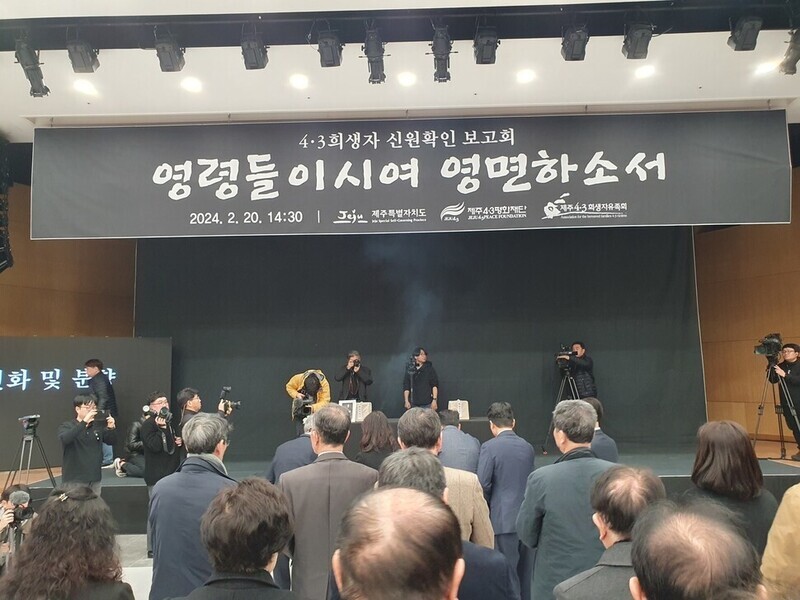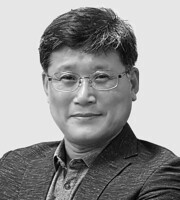hankyoreh
Links to other country sites 다른 나라 사이트 링크
[Column] Syngman Rhee’s bloody legacy in Jeju


By Heo Ho-Joon, senior Jeju correspondent
“Am I supposed to call Syngman Rhee ‘president’? Or should I just call him Rhee?” asked a 104-year-old woman standing in the chamber of the Jeju District Court during a retrial for those imprisoned during the Jeju April 3 Incident on April 2, 2021.
“My husband should have been released after serving the sentence that man gave him. How could that man just have him killed as he pleased? It still festers in my heart.” Though her comments were short, they contained decades of rage and resentment.
During the tragic events of the Jeju April 3 uprising and subsequent massacres, she was separated from her husband while fleeing with him and their young children after their house was burned down. To this very day, the centenarian waits for her husband, but her husband remains forever in his 20s, unable to find his way back to his Jeju home.
Jeju Confucian scholar Kim Kyung-jong (1888-1962), wrote a piece titled “The Condemnation of Syngman Rhee” in 1950 in which he acerbically rebuked Rhee for the massacre of ordinary citizens that took place after the beginning of the Korean War.
“Centuries ago, Xiang Yu killed 400,000 Qin soldiers who had already surrendered. The entire world condemned him as ruthless. Now, Rhee has killed hundreds of thousands of prisoners within the country, so how does his ruthlessness compare to Xiang Yu of yore?” Kim asked.
“Even a thousand beheadings and ten thousand cruel slaughters are not enough to make Rhee atone for his sins. He dares to abuse his status as president to act as a god lording over the masses,” the scholar went on.
“The dozens of prisons in South Korea are overflowing, with hundreds of thousands of inmates. When the North Korean army advanced to the South, those in power hastily ordered a massacre, claiming that those imprisoned would blindly follow the orders of the North. Rhee’s tyranny has brought us to this point,” Kim railed.
This was in the immediate aftermath of the Korean War, when hundreds of thousands of people were killed in preventive detention and prison inmates were massacred. Kim’s own son was locked up in a mainland prison during the Jeju April 3 incident and was never seen again.
According to the “Jeju 4.3 Incident Investigation Report,” published in 2003 by the National Committee for Investigation of the Truth about the Jeju 4.3 Events, the commanding structures behind mass casualties was such that “the ultimate responsibility goes to President Rhee Syngman,” concluding that Rhee was behind the deaths of countless Jeju residents during the ruthless period on the island.
On Nov. 17, 1948, Rhee proclaimed martial law on Jeju. Martial law was used not only to restrict civil rights but also as a weapon to justify the massacre of civilians. From that point on, punitive forces ramped up their scorched-earth operations, turning the island into a cacophony of countless screams.
The military police and the Northwest Youth Association, a right-wing paramilitary group, were unflagging in their efforts to eradicate communists, never wavering in their attempts to wipe out all of those they deemed “commies.” Villagers were rounded up, forced to kill their neighbors, and were not allowed to avert their eyes from the brutal scenes.
That was the reality of Jeju in 1948 and 1949. The word “inhumane” is utterly insufficient to describe the acts of savagery that took place there at the time.
According to a report by the US Provisional Military Advisory Group, in the five days following Nov. 24, 1948, the 9th Regiment killed 337 people and captured 332 in Jeju alone, despite only confiscating seven guns in total.
On Dec. 13 of the same year, the punitive forces sent in to suppress the island utilized around 3,000 police and civilians to kill 105 people in a single day. They ran amok, engaging in indiscriminate slaughter. The 2nd Regiment, which was sent to the region after the 9th Regiment, was equally brutal.
Despite the deaths of so many Jeju residents, Rhee doggedly pushed for a crackdown. In a Cabinet meeting held on Jan. 21, 1949, he said, “The US acknowledges the importance of Korea and is sympathetic. But the US’s assistance will only be possible with our accurate removal of the aftereffects of Jeju Incidents and Jeonnam Incidents and the dignity of law is needed at once by suppressing villains including local objectors and thieves.”
The atrocities did not end there. On Oct. 2, 1949, 249 people who had been sentenced to death by court-martial were executed in a mass execution at Jeju Airfield, which is now the site of Jeju International Airport, with Rhee’s approval.
The unrest in Jeju was coming to an end by that point, and the mass execution of over 240 souls was unprecedented. And yet, not a single word about this was reported in any press at the time.
Jeju was a lone island, isolated from the outside world, and its isolation was brought about and enforced by Rhee.
There are plans to construct a memorial hall for Rhee in central Seoul and erect a statue of him. If only we could hear the wails of all those lost Jeju souls, weeping in the afterlife.
Please direct questions or comments to [english@hani.co.kr]

Editorial・opinion
![[Column] Season 2 of special prosecutor probe may be coming to Korea soon [Column] Season 2 of special prosecutor probe may be coming to Korea soon](https://flexible.img.hani.co.kr/flexible/normal/500/300/imgdb/original/2024/0426/3317141030699447.jpg) [Column] Season 2 of special prosecutor probe may be coming to Korea soon
[Column] Season 2 of special prosecutor probe may be coming to Korea soon![[Column] Park Geun-hye déjà vu in Yoon Suk-yeol [Column] Park Geun-hye déjà vu in Yoon Suk-yeol](https://flexible.img.hani.co.kr/flexible/normal/500/300/imgdb/original/2024/0424/651713945113788.jpg) [Column] Park Geun-hye déjà vu in Yoon Suk-yeol
[Column] Park Geun-hye déjà vu in Yoon Suk-yeol- [Editorial] New weight of N. Korea’s nuclear threats makes dialogue all the more urgent
- [Guest essay] The real reason Korea’s new right wants to dub Rhee a founding father
- [Column] ‘Choson’: Is it time we start referring to N. Korea in its own terms?
- [Editorial] Japan’s rewriting of history with Korea has gone too far
- [Column] The president’s questionable capacity for dialogue
- [Column] Are chaebol firms just pizza pies for families to divvy up as they please?
- [Column] Has Korea, too, crossed the Rubicon on China?
- [Correspondent’s column] In Japan’s alliance with US, echoes of its past alliances with UK
Most viewed articles
- 1‘We must say no’: Seoul defense chief on Korean, USFK involvement in hypothetical Taiwan crisis
- 2Why Kim Jong-un is scrapping the term ‘Day of the Sun’ and toning down fanfare for predecessors
- 3Two factors that’ll decide if Korea’s economy keeps on its upward trend
- 4BTS says it wants to continue to “speak out against anti-Asian hate”
- 5After election rout, Yoon’s left with 3 choices for dealing with the opposition
- 6Gangnam murderer says he killed “because women have always ignored me”
- 7South Korea officially an aged society just 17 years after becoming aging society
- 8AI is catching up with humans at a ‘shocking’ rate
- 9Ethnic Koreans in Japan's Utoro village wait for Seoul's help
- 1046% of cases of violence against women in Korea perpetrated by intimate partner, study finds